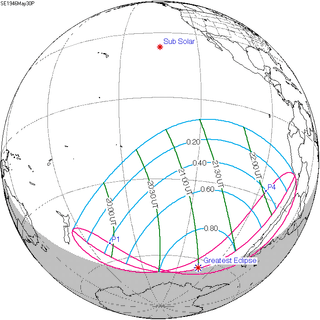Solar eclipse of May 9, 1948
| Solar eclipse of May 9, 1948 | |
|---|---|
 Map | |
| Type of eclipse | |
| Nature | Annular |
| Gamma | 0.4133 |
| Magnitude | 0.9999 |
| Maximum eclipse | |
| Duration | 0 sec (0 m 0 s) |
| Coordinates | 39°48′N 131°12′E / 39.8°N 131.2°E |
| Times (UTC) | |
| Greatest eclipse | 2:26:04 |
| References | |
| Saros | 137 (32 of 70) |
| Catalog # (SE5000) | 9394 |
An annular solar eclipse occurred on May 9, 1948. A solar eclipse occurs when the Moon passes between Earth and the Sun, thereby totally or partly obscuring the image of the Sun for a viewer on Earth. An annular solar eclipse occurs when the Moon's apparent diameter is smaller than the Sun's, blocking most of the Sun's light and causing the Sun to look like an annulus (ring). An annular eclipse appears as a partial eclipse over a region of the Earth thousands of kilometres wide.
Related eclipses
Solar eclipses 1946-1949
Each member in a semester series of solar eclipses repeats approximately every 177 days and 4 hours (a semester) at alternating nodes of the Moon's orbit.
| Ascending node | Descending node | |||
|---|---|---|---|---|
| 117 | May 30, 1946 Partial |
122 | November 23, 1946 Partial | |
| 127 | May 20, 1947 Total |
132 | November 12, 1947 Annular | |
| 137 | May 9, 1948 Annular |
142 | November 1, 1948 Total | |
| 147 | April 28, 1949 Partial |
152 | October 21, 1949 Partial | |
Notes
References
- Earth visibility chart and eclipse statistics Eclipse Predictions by Fred Espenak, NASA/GSFC
| Wikimedia Commons has media related to Solar eclipse of 1948 May 9. |
This article is issued from Wikipedia - version of the 4/27/2015. The text is available under the Creative Commons Attribution/Share Alike but additional terms may apply for the media files.
